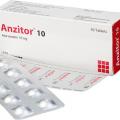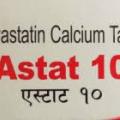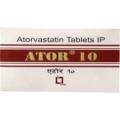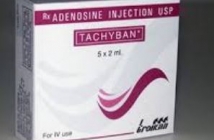Home / Categories / LIPICURE-10MG
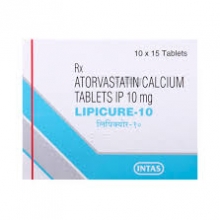
LIPICURE-10MG
(10SX15T)
ATORVASTATIN-10MG
HYPOLIPIDAEMIC DRUGS
INTAS PHARMACEUTICAL-ALTIMA DIVISION
Product Details
Atorvastatin Calcium
Actions
Indications
Contraindications
Route/Dosage
Interactions
Lab Test Interferences
Adverse Reactions
PrecautionsPatient Care Considerations
Administration/Storage
Assessment/Interventions
Patient/Family Education
(ah-TORE-vah-STAT-in)LipitorTablets: 10 mgTablets: 20 mgTablets: 40 mgTablets: 80 mgClass: AntihyperlipidemicHMG-CoA reductase inhibitor
 Actions Increases rate at which body removes cholesterol from blood and reduces production of cholesterol in body by inhibiting enzyme that catalyzes early rate-limiting step in cholesterol synthesis; increases HDL; reduces LDL, ULDL, and triglycerides.
Actions Increases rate at which body removes cholesterol from blood and reduces production of cholesterol in body by inhibiting enzyme that catalyzes early rate-limiting step in cholesterol synthesis; increases HDL; reduces LDL, ULDL, and triglycerides.
 Indications Hypercholesterolemia: Adjunct to diet to reduce elevated total cholesterol, LDL cholesterol, apolipoprotein B, and triglyceride levels. Type III familial hyperlipoproteinemia: To treat patients with primary dysbetalipoproteinemia (Fredrickson type III) who do not respond adequately to diet. Elevated serum triglyceride: As an adjunct to diet for the treatment of patients with elevated serum triglyceride levels (Fredrickson type IV). Homozygous familial hypercholesterolemia: To reduce total cholesterol and LDL cholesterol in patients with homozygous familial hypercholesterolemia as an adjunct to other lipid-lowering treatments or if such treatments are unavailable.
Indications Hypercholesterolemia: Adjunct to diet to reduce elevated total cholesterol, LDL cholesterol, apolipoprotein B, and triglyceride levels. Type III familial hyperlipoproteinemia: To treat patients with primary dysbetalipoproteinemia (Fredrickson type III) who do not respond adequately to diet. Elevated serum triglyceride: As an adjunct to diet for the treatment of patients with elevated serum triglyceride levels (Fredrickson type IV). Homozygous familial hypercholesterolemia: To reduce total cholesterol and LDL cholesterol in patients with homozygous familial hypercholesterolemia as an adjunct to other lipid-lowering treatments or if such treatments are unavailable.
 Contraindications Active liver disease or unexplained persistent elevation of serum transaminases; pregnancy; lactation.
Contraindications Active liver disease or unexplained persistent elevation of serum transaminases; pregnancy; lactation.
 Route/Dosage
Route/Dosage
ADULTS: PO 10 to 80 mg/day.
 Interactions
Interactions
Azole antifungal agents (eg, itraconazole), cyclosporine, macrolide antibiotics (eg, erythromycin), gemfibrozil, grapefruit juice, niacin, verapamil: Severe myopathy or rhabdomyolysis may occur. Antacids: Coadministration may decrease atorvastatin levels. Digoxin: Elevated digoxin levels may occur. Oral contraceptives: Coadministration increases AUC for norethindrone and ethinyl estradiol.
 Lab Test Interferences None well documented.
Lab Test Interferences None well documented.
 Adverse Reactions
Adverse Reactions
CNS: Headache; dizziness; asthenia; insomnia; paresthesia. DERMATOLOGIC: Rash. GI: Constipation; diarrhea; flatulence; dyspepsia; abdominal pain; nausea. HEPATIC: LFT abnormalities. RESPIRATORY: Sinusitis; pharyngitis; rhinitis; bronchitis. OTHER: Flu-like syndrome; asthenia; leg and back pain; arthralgia; myalgia; arthritis; chest pain; allergy; accidental trauma; alopecia; infection; peripheral edema.
 Precautions
Precautions
Pregnancy: Category X. Lactation: Contraindicated in nursing women. CHILDREN: Safety and efficacy not established. Liver disease: Use with caution in patients who consume substantial quantities of alcohol or have a history of liver disease. Skeletal muscle effects: Rhabdomyolysis with renal dysfunction secondary to myoglobinuria has occurred in this class of drugs. Consider myopathy in any patient with diffuse myalgias, muscle tenderness or weakness, or marked elevation of CPK.
PATIENT CARE CONSIDERATIONS
 Administration/Storage
Administration/Storage
- Take as a single dose at any time of the day, with or without food.
- Store medication at room temperature.
 Assessment/Interventions
Assessment/Interventions
- Obtain patient history, including drug history and any known allergies. Note hepatic impairment, alcohol consumption, and other medications that may increase risk of myopathy.
- Ensure that blood cholesterol and triglyceride levels are assessed before beginning therapy and repeated periodically during therapy.
- Place patient on standard cholesterol-lowering diet before beginning therapy and continue diet during treatment.
- Ensure that LFTs are performed before initiation of therapy, at 6 and 12 wk after initiation of therapy, or after dose increase.
- If elevated serum transaminase levels develop during treatment, repeat tests more frequently.
- If transaminase levels rise to 3 times upper limit of normal and are persistent, notify health care provider. Drug may be discontinued.
- If muscle tenderness or weakness develops during therapy, monitor CPK levels. Notify health care provider if CPK levels are markedly increased or if symptoms continue.
- Place patient on a standard cholesterol-lowering diet before receiving atorvastatin, and have patient continue on this diet during atorvastatin treatment.
 Patient/Family Education
Patient/Family Education
- Caution patient that this medication must not be taken during pregnancy or when pregnancy is possible. Advise patient to use reliable form of birth control while taking this drug.
- Advise patient to take as a single daily dose at about the same time every day. Remind patient that the drug can be taken without regard to meals.
- May cause sensitivity to sunlight. Avoid prolonged exposure to the sun and other ultraviolet light. Use sunscreen and wear protective clothing until tolerance is determined.
- Explain importance of adhering to a low-cholesterol, low-fat diet during treatment. Suggest consultation with nutritionist as needed.
- Instruct patient to report the following symptoms to health care provider: unexplained muscle pain, tenderness, or weakness, especially if accompanied by fever or malaise.
- Caution patient to avoid or decrease alcohol intake.
- Advise patient not to take any additional medications or supplementation without approval by health care provider.
- Emphasize importance of returning for follow-up liver function and blood cholesterol tests as instructed.
- Explain that this treatment must be continued over years.
Books@Ovid
Copyright © 2003 Facts and Comparisons
David S. Tatro
A to Z Drug Facts
